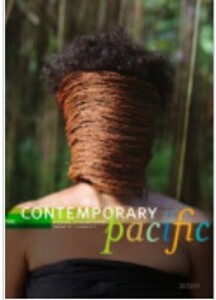Hernawan, Budi (2020) Papua. The Contemporary Pacific, 32 (2). pp. 578-587. ISSN 1527-9464; 1043-898X
![[img]](http://repo.driyarkara.ac.id/335/1.hassmallThumbnailVersion/COVERpapua-BHN.jpg)
|
Image (Journal cover image)
COVERpapua-BHN.jpg - Cover Image Download (12kB) | Preview |
Abstract
In lieu of an abstract, here is a brief excerpt of the content: Renewed violence, access restrictions for outsiders, and imprisonment best encapsulate Papua’s calendar for 2019. Unlike in previous years, which each featured numerous issues, in 2019, two major issues dominated the whole Papua chronicle: the protracted conflict of Nduga and the racist attacks on Papuan students in Surabaya, East Java. Both issues not only have colored the media but also, more importantly, have affected local, national, and international politics. The aftermath of the killing of road workers in Nduga District in December 2018 remained unresolved at the end of 2019. The joint operation of police and the Indonesian National Armed Forces (TNI) to hunt down the West Papua National Liberation Army (TPN-PB) led by Egianus Kogoya started in April 2019 when some six hundred Indonesian military personnel were deployed to the Nduga area (Pramono 2019, 30). The government troops took control of the district capital of Kenyam and remained stationed there. By the end of 2019, the joint operation had not yielded in either capturing perpetrators or securing the area. Colonel Jonathan Binsar Parluhutan Sianipar, the commander of the Nduga operation, made it clear that he will not stop “until the Free Papua Movement (OPM) is crushed” (Pramono 2019, 38). On the other side, the Egianusled TPN-PB continued their guerilla tactics, launching sporadic attacks on TNI posts and killing soldiers in Mugi district in March, May, and December (Jakarta Post 2019b; Jakarta Post 2019a; JPNN 2019). These attacks [End Page 578] demonstrated that Egianus Kogoya’s group is active and deadly. Further, TPN-PB’s operations have not been limited to Nduga area. The media recorded that TPN-PB was also active in the Indonesia–Papua New Guinea border areas of Keerom, Bilogai, and Timika. In other words, the impact of prolonged armed conflict on Papuan civilians has to be assessed thoroughly in order to understand the scale of the conflict and measures that must be taken to protect civilians. One thing that is already occurring is the large displacement of Nduga Regency populations, who are scattered in four neighboring regencies including Jayawijaya, Asmat, Lani Jaya, and Mimika (Pramono 2019, 36–38). This is a clear sign that the situation in the Nduga area is far from normal. Schools, government offices, markets, and churches have been shut down. During a rare visit of the World Council of Churches delegation to Wamena, Bishop Abednego Keshomshahara of the Evangelical Lutheran Church in Tanzania expressed his concerns: “It was painful to see so many child victims of this violence who fear to return home because of the presence of military and police who should be the ones protecting them in their villages and schools” (World Council of Churches 2019). Casualties of civilians and of weapon bearers are unequal. To respond to the needs of Nduga’s internally displaced persons (IDPs) in Wamena, including more than six hundred children, local nongovernmental organization Yayasan Teratai Hati Papua (YTHP) built a shelter to house a temporary school (Geong 2019; Pramono 2019, 37; YTHP 2019). However, instead of gaining public and government support, the Wamena volunteers who look after the school with their limited resources have experienced rejection and even pressure from local authorities, especially the local army commander, who felt embarrassed by the YTHP initiative and asked the head of Education Office either to send the children back to Kenyam or to relocate the school to the district military command’s hall. The IDPs rejected both proposals since they did not want to put their children at risk (Haluk 2019, 86–87). Despite the unhindered flow of social media, Papua remains inaccessible for independent observers, including national and international journalists, human rights observers, and even Indonesia’s National Human Rights Commission (Komnas HAM). The situation makes it hard to independently verify any claims of incidents between government forces and the TPN-PB. Only local nongovernmental organizations and the Papuan People’s Council (Majelis Rakyat Papua, or MRP) have access to Kenyam, the capital of Nduga, and the surrounding area to evacuate victims of the conflict. The International Coalition for Papua estimated that by year’s end 238 people had died in Nduga due to the joint forces operation...
| Item Type: | Article |
|---|---|
| Subjects: | H Social Sciences > H Social Sciences (General) H Social Sciences > HN Social history and conditions. Social problems. Social reform |
| Divisions: | Program Pascasarjana > Program Pascasarjana Filsafat |
| Depositing User: | ThM .- |
| Date Deposited: | 20 Sep 2021 02:04 |
| Last Modified: | 20 Sep 2021 02:04 |
| URI: | http://repo.driyarkara.ac.id/id/eprint/335 |
Actions (login required)
 |
View Item |


